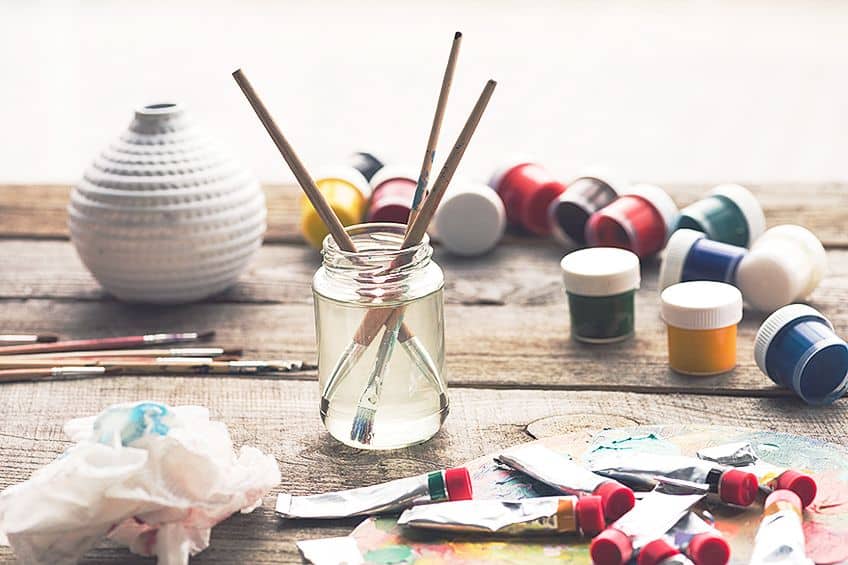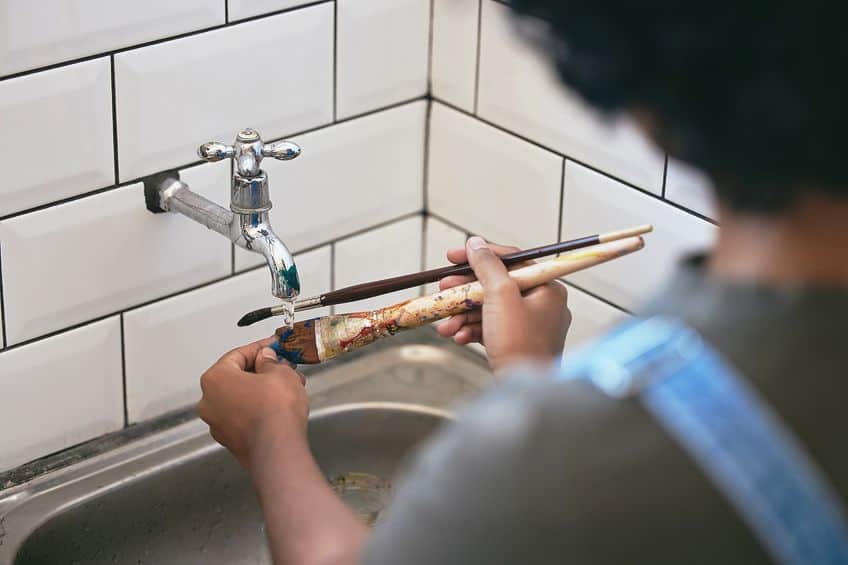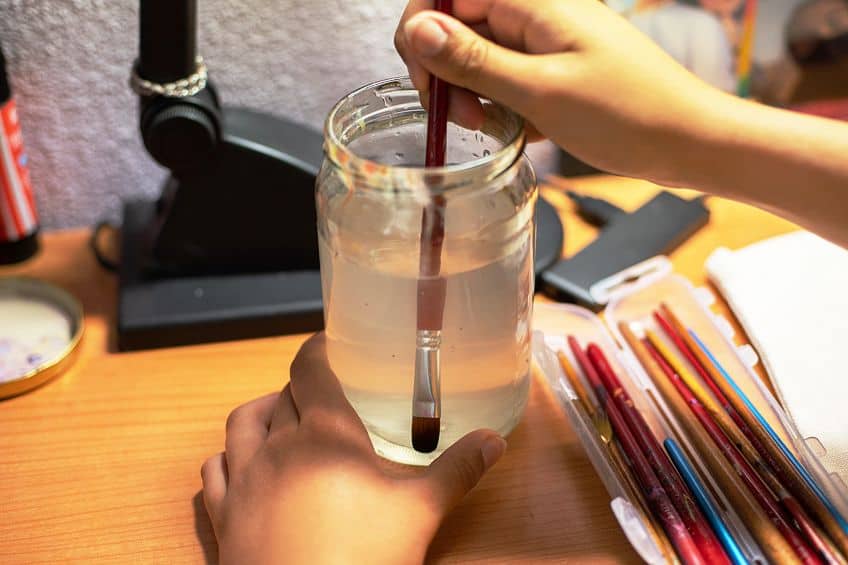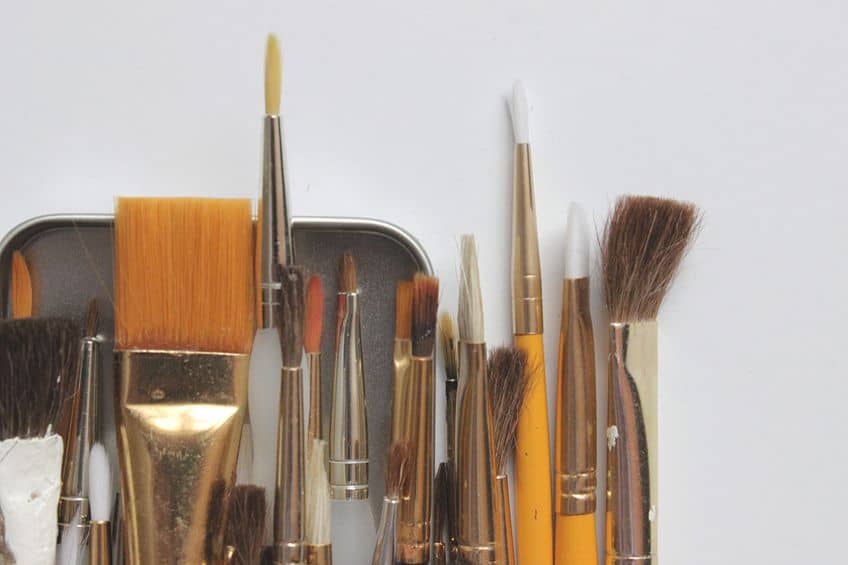How to Clean Acrylic Paint Brushes – Cleaning Paint Brushes
A good paint brush can be expensive, which is why it is so important to look after them. Properly cleaning and caring for acrylic paint brushes will guarantee that they can be used for many years. Below, we have created this handy guide on how to clean acrylic paint brushes to ensure that they last, as well as what to do if you accidentally let the acrylic paint dry.
Different Types of Paint Brushes
Before learning how to clean acrylic paint off brushes, it is helpful to have an understanding of the materials used to make them. Paint brushes are classified broadly into natural and synthetic brushes. This is determined by the type of bristles that make up these brushes and has a huge impact on how successful you will be cleaning acrylic paint brushes.
Natural Brushes
Natural brushes have bristles that are made from fibers such as boar hair, badger, squirrel, or sable. They are much coarser and hardier than synthetic brushes and can be used with heavier acrylic paints. Professional artists generally opt for natural brushes as they are hardier, easier to clean, and can be used with different acrylic mediums. Cleaning wet paint off natural bristle brushes is often more difficult than cleaning acrylic brushes that are synthetic, as the paint sticks to the hairs.
Cleaning dried paint, however, is much easier as the durability of natural brushes means you have a better chance that the solvents or cleaners will not damage them.
Synthetic Brushes
Made from manufactured materials such as polyester or nylon, synthetic brushes are much softer than natural brushes. Synthetic brushes have a smoother finish bristle and are easier to clean than natural brushes while the acrylic paint is still wet. Cleaning dried acrylic paint off these brushes, however, can be almost impossible without them being irreversibly damaged by the hardened acrylic paint. This is because the synthetic bristles can be dissolved by most solvents resulting in fraying and breakage.
How to Clean Acrylic Paint off Brushes During Painting
Knowing how to clean an acrylic paintbrush properly is a vital skill all artists should learn. Cleaning your brushes correctly as you paint will not only ensure that you do not muddy your colors but also make storing your brushes easier. For a thorough acrylic paint cleaning up, start by gently wiping your paintbrush over a paper towel or rag to remove any excess paint. Continue brushing the paintbrush until it stops leaving marks and do not forget to work the cloth around the ferrule of the brush.
Once you have removed the majority of the paint, simply swirl the paint brush in clean water and wipe it on a paper towel to remove the excess water and any residual paint.
Do not keep the brush submerged for a long time. Using an artist brush tub or a container with ridges along the inside will help you remove any residual paint more effectively. Some artists have also had success with using two cups of water, one for cleaning the excess acrylic paint off and another for rinsing the muddy water off so it does not dirty your paints. After this step, you can now load your brush with a new color to continue painting or clean your brush more thoroughly before storing them for the next session.
How to Clean Acrylic Paint Brushes Using Water and Soap
Simply rinsing your brushes in water will not clean them thoroughly enough for storage. Brushes, especially natural bristle brushes, hold a lot of hidden paint that will eventually deform and damage the bristles of your brush over time. To properly clean your brush, you will need to use soap and warm water. Start by holding your brush under lukewarm water and moving the brush around and pinching the bristles and trying to gently dislodge any visible paint with your fingers. You can also rotate your brush under the tap for five to ten seconds to allow the water pressure to loosen the paint.
Next, add a small amount of a mild soap or artist soap onto the brush and gently work it into the bristles using your fingers.
Make sure to work the soap into the inner bristles, especially with much larger and thicker brushes, as paint can often be trapped there. Shampoo can also be used in place of soap; however, you will need to rinse these brushes out thoroughly to ensure that there is no residue left on your brush that will affect your acrylic paints. Work the soap into the ferrule of the brush as well, which is the metal tube that fastens the bristles to the handle of the brush. Any paint left to dry there will eventually cause the bristles to spread as it hardens, altering the shape of the brush. Rinse the soap out using lukewarm water until it runs clear.
After rinsing the brush, add a dime-sized amount of the soap into your palm and swirl the brush around in the soap using your other hand. This swirling action mimics the motion of your brush during painting and helps the soap target those hard-to-reach areas, especially the underside of the ferrule. After you rinse the last remaining soap out of your brush it should be completely clean of paint. Dry any excess water off by squeezing the bristles in a paper towel or rag and lay it out to dry horizontally. Drying or storing your paintbrushes vertically can warp the bristles of your paintbrush out of shape.
If any dried acrylic paint is not removed from your synthetic brushes using this method, then it is unlikely that the paint can be cleaned off without damaging the brush. You can still attempt to use the methods below, however.
How to Clean Dried Acrylic Paint Brushes
You might think that since acrylic paint is water-soluble, cleaning dried acrylic paint is as simple as adding water, however, acrylic paint actually becomes water-resistant once dry. While this is great for the longevity of your pieces, it is not so great for acrylic paint cleaning up. Acrylic paints’ fast-drying properties are perfect for creating quick and vibrant paintings; however, it also means you have to be extra careful to ensure they do not dry out. Dried acrylic paint can change your once supple brush into a rock-hard acrylic bound brush, not fit for any kind of painting.
While at first glance your brushes may seem ruined, you might still be able to salvage them.
Knowing how to clean an acrylic paint brush that has dried can save you time and money. Remember, the longer the paint has been left to dry on the brush the harder it will be to remove without harming the brush. Some very delicate brushes, such as synthetic brushes, may be irreversibly damaged from dried acrylic paint even after only one day whereas a few months of dried paint will prove near impossible to remove from even natural brushes. Below we have detailed how to clean dried acrylic paint off brushes using various methods
How to Clean Dried Acrylic Paint off Brushes Using Acetone
Acetone is a solvent found in nail polish remover and can be used on dried paint brushes to penetrate the bristles and dissolve the acrylic paint. While acetone can be difficult to find, nail polish remover is widely available and budget friendly. Acetone does produce very strong fumes so ensure that you use it in a well-ventilated area along with gloves as prolonged exposure can also irritate your skin. To use acetone for cleaning acrylic brushes, place the brushes in a glass jar and pour just enough acetone to cover the bristles and half the ferrule. You do not want to completely cover the ferrule as the acetone could dissolve the glue keeping your bristles together.
Rather, use a scraper to scrape off any dried paint off the ferrule, followed by a cloth dipped in acetone to wipe off any excess paint.
Allow the brush to soak for three to five minutes, after which wash thoroughly with warm water and dishwashing liquid using your fingers to gently massage the bristles and loosen the dried paint. If any pieces of acrylic paint remain, repeat this process. Once you have removed all the dried acrylic paint, allow the brushes to dry lying flat. Do not leave your paint brushes sitting in the solution for an extended period and will cause your bristles to become brittle and easily fray or break.
How to Clean Dried Acrylic Paint off Brushes Using Isopropyl Alcohol
Isopropyl alcohol is found in rubbing alcohol and provides a similar method for cleaning acrylic paint brushes to acetone. This alcohol also penetrates bristles to break down the acrylic paint, however, it is not as strong-smelling as acetone. Many acrylic brush cleaners have isopropyl alcohol as the active ingredient that cleans your brushes.
Isopropyl alcohol is not very harsh on natural bristles; however, the solvent can ruin synthetic brushes.
The method for cleaning acrylic brushes with isopropyl is very similar to using acetone. Cover the bristles of your brush with the solvent and allow them to soak for five minutes. Wash the brush completely with soap and water until all loosened paint has been removed. Like with acetone, if any paint remains on the brush, you can soak the brush again and repeat this process.
How to Clean Dried Acrylic Paint off Brushes Using Hand Sanitizer
Hand sanitizer is similar to isopropyl but contains ethyl alcohol instead. It is very effective for removing dried acrylic paint off brushes and can be easier to use as it does not have strong fumes and is not as harsh on skin. Because of this you can simply squeeze some hand sanitizer directly onto the brush and rub it through the brush bristles to clean it.
Do this for a few minutes and then rinse the brushes with soapy water like with isopropyl and repeat until all the chunks of paint have been removed.
How to Clean Acrylic Paint Brushes Using Acrylic Brush Cleaner
Acrylic brush cleaner is another great option for cleaning dried acrylic paint off brushes. These are specialized brush cleaners that are safer for synthetic brushes than the other solvents we have covered and have much weaker odors. Acrylic brush cleaners also extend the working life of your brush as it includes other beneficial oils and moisturizers aside from simply cleaning. Brush cleaners are available in both liquid and solid forms, so be sure to follow the manufacturer’s instructions for your specific cleaner.
Physically Removing Dried Acrylic Paint from Brushes
While using chemicals to dissolve dried acrylic paint requires less effort and less chance of ripping out bristles, you can also use physical methods to remove the paint. An old comb can be a cost-effective option for removing paint from a brush. To use a comb, first wet your brush or add a few drops of oil such as linseed or olive oil to give the paint some slip on the bristles. Opt for a fine-tooth comb for the best results and gently brush from the bottom up slowly teasing the paint loose. To minimize breakage or accidentally removing bristles from the ferrule, make sure to firmly hold the brush at the point where the bristles and ferrule meet.
Work slowly and wash the brush with soapy water once you have finished.
What to Do With a Damaged Brush
If you have tried to remove the dried paint, however, [too far gone] your last option is to trim the dried acrylic paint out of the brush. Doing this will likely damage your brush on many levels, however, do not throw it out just yet. Cut brushes can be used for different painting techniques such as stippling or spattering to create interesting textural effects.
Post-Brush Cleaning Care
Whether you use acetone, isopropyl alcohol, or a brush cleaner to clean your brushes, conditioning your brushes is a great practice to revitalize your brushes after cleaning. The shape of your brushes’ bristles impacts not only the look of your final piece, but also the ease with which certain painting techniques can be performed. It is therefore very important to preserve the shape of your brush.
Conditioning Your Brushes
Conditioning your brushes is the final step to not only ensure that all the paint residue has been removed from the bristles, but also that the softness and spring have been preserved. Regular conditioning helps your acrylic brushes hold more paint and prevents the build-up of paint below the ferrule. Aside from special-bought conditioners, regular hair conditioners can also be used. Simply apply the conditioner of your choice to a clean brush and massage it through.
Leave the conditioner on the brush for a few minutes and then rinse the bristles thoroughly.
Preserve Your Brushes’ Shape
The way you store your paint brushes, while in use as well as during cleaning, can have a large impact on their longevity and preserve the shape of the bristles. Never leave your brushes sitting in water for an extended period, as this will cause the brushes’ bristles to splay. After washing your brushes, do not leave them to dry standing upright. Rather, smooth and shape the hairs and then lay it flat to dry on a clean kitchen towel or rag. This way your bristles will hold their shape and you will also prevent water from running into the ferrule and dissolving the glue that holds the bristles.
Habits for Keeping Your Brush Clean
There are many habits you can use in your painting to prevent acrylic paint from drying on your brushes, protecting your brush bristles and making them easier to clean. When you are painting using multiple brushes and going long times between using each brush, it is important to remember to occasionally dip the brushes into the paint. This keeps the paint on your brush wet and ensures that they do not dry out, interrupting your painting and becoming a hassle to remove later. If you are no longer using the brush or color, swirl your brush in water to remove the excess paint.
This prepares the brush to be thoroughly cleaned later and prevents the paint from drying on the bristles.
Do not leave your brushes in the water as this will cause the bristles to splay and get bent out of shape, as well as slowly dissolve the glue that holds them together. Rather, lay your brushes flat on some paper towel or a clean rag. Avoid getting paint on the ferrule. Do not dip your brush completely into your acrylic paint, instead only dip the first three-quarters of the bristles into the paint. Paint on the ferrule is much harder to clean as the bristles are more compact here and any paint left behind will harden as it dries, splaying your bristles.
Keeping your brushes clean while you paint will improve their longevity and preserve their shape. While preventing your acrylic paint from drying while you paint will ensure that you do not struggle to remove it later, there are various methods for removing acrylic paint that has unexpectedly dried. Care is key, and simple upkeep habits like these will keep you on top of your painting game for longer.
Frequently Asked Questions
How to Clean Dried Acrylic Paint Brushes?
There are many methods for cleaning dried paint off of both synthetic and natural brushes. Washing your brushes with a mild soap and water or a specialized acrylic brush cleaner is perfect for delicate synthetic bristles. Hardier, natural brushes can be cleaned using acetone, isopropyl alcohol, or a sanitizer by soaking the bristles for five minutes and then washing them with soap and water. The longer the paint has been left on the brush, the harder it will be to remove it without damaging the bristles.
How to Use an Acrylic Brush Cleaner?
To clean a brush using a brush cleaner, first blot any excess paint off using a paper towel or rag, and rinse it in lukewarm water. Next, apply a small amount of the cleaner onto the bristles and swirl the brush against the inside of a container to lather the soap. A ridged or bumpy surface will make this easier, as well as help to loosen any residual paint. Lastly, rinse the soap out of the brush with lukewarm water and allow it to dry flat on a paper towel. An acrylic brush cleaner makes cleaning acrylic brushes much easier than just using water, and they often contain other beneficial oils for your brushes.
Megan is a writer and researcher who holds a degree in Social Sciences, with a specialization in Psychology and Environmental Science, from the University of Cape Town. Her dedication to acquiring knowledge and making a positive impact has driven her current work in promoting conscious and sustainable growth in Southern Africa. Megan’s interests encompass exploring the physical and psychological impacts of color in our environment on our mood and well-being. She is also passionate about the role of art and creativity, which has been an integral part of society since the beginning of human history. Since 2022, Megan has been contributing blog posts on painting and color theory at artfilemagazine.
Learn more about Megan van Schoor and about us.
Cite this Article
Megan, van Schoor, “How to Clean Acrylic Paint Brushes – Cleaning Paint Brushes.” artfilemagazine – Your Online Art Source. June 6, 2023. URL: https://artfilemagazine.com/how-to-clean-acrylic-paint-brushes/
van Schoor, M. (2023, 6 June). How to Clean Acrylic Paint Brushes – Cleaning Paint Brushes. artfilemagazine – Your Online Art Source. https://artfilemagazine.com/how-to-clean-acrylic-paint-brushes/
van Schoor, Megan. “How to Clean Acrylic Paint Brushes – Cleaning Paint Brushes.” artfilemagazine – Your Online Art Source, June 6, 2023. https://artfilemagazine.com/how-to-clean-acrylic-paint-brushes/.












